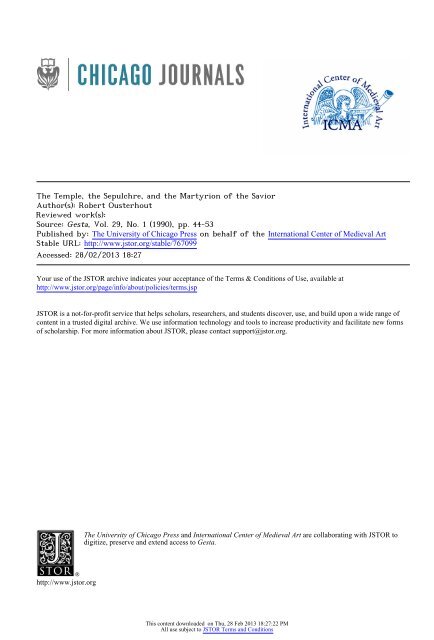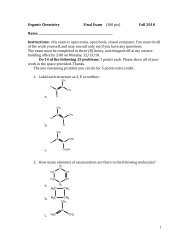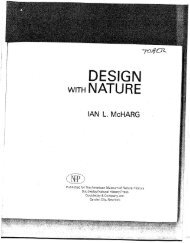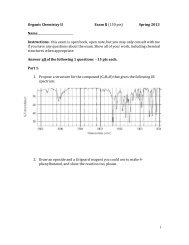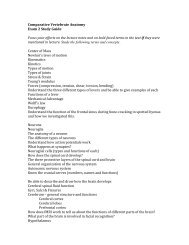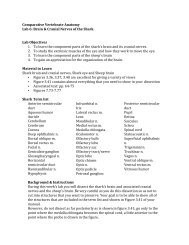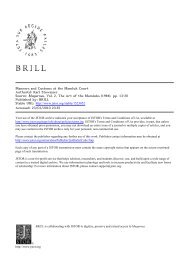The Temple, the Sepulchre, and the Martyrion of the Savior - Courses
The Temple, the Sepulchre, and the Martyrion of the Savior - Courses
The Temple, the Sepulchre, and the Martyrion of the Savior - Courses
Create successful ePaper yourself
Turn your PDF publications into a flip-book with our unique Google optimized e-Paper software.
<strong>The</strong> <strong>Temple</strong>, <strong>the</strong> <strong>Sepulchre</strong>, <strong>and</strong> <strong>the</strong> <strong>Martyrion</strong> <strong>of</strong> <strong>the</strong> <strong>Savior</strong>Author(s): Robert OusterhoutReviewed work(s):Source: Gesta, Vol. 29, No. 1 (1990), pp. 44-53Published by: <strong>The</strong> University <strong>of</strong> Chicago Press on behalf <strong>of</strong> <strong>the</strong> International Center <strong>of</strong> Medieval ArtStable URL: http://www.jstor.org/stable/767099 .Accessed: 28/02/2013 18:27Your use <strong>of</strong> <strong>the</strong> JSTOR archive indicates your acceptance <strong>of</strong> <strong>the</strong> Terms & Conditions <strong>of</strong> Use, available at .http://www.jstor.org/page/info/about/policies/terms.jsp.JSTOR is a not-for-pr<strong>of</strong>it service that helps scholars, researchers, <strong>and</strong> students discover, use, <strong>and</strong> build upon a wide range <strong>of</strong>content in a trusted digital archive. We use information technology <strong>and</strong> tools to increase productivity <strong>and</strong> facilitate new forms<strong>of</strong> scholarship. For more information about JSTOR, please contact support@jstor.org..<strong>The</strong> University <strong>of</strong> Chicago Press <strong>and</strong> International Center <strong>of</strong> Medieval Art are collaborating with JSTOR todigitize, preserve <strong>and</strong> extend access to Gesta.http://www.jstor.orgThis content downloaded on Thu, 28 Feb 2013 18:27:22 PMAll use subject to JSTOR Terms <strong>and</strong> Conditions
AW<strong>The</strong> <strong>Temple</strong>, <strong>the</strong> <strong>Sepulchre</strong>,<strong>and</strong> <strong>the</strong> <strong>Martyrion</strong> <strong>of</strong> <strong>the</strong> <strong>Savior</strong>*ROBERT OUSTERHOUTUniversity <strong>of</strong> Illinois at Urbana-ChampaignIn memory <strong>of</strong> Kathleen SheltonAbstractThis paper examines <strong>the</strong> ideological relationship<strong>of</strong> <strong>the</strong> Holy <strong>Sepulchre</strong> <strong>and</strong> <strong>the</strong> <strong>Temple</strong> <strong>of</strong> Jerusalem,as manifest in writings, ceremonies, <strong>and</strong> architecture.A possible relationship between <strong>the</strong> form <strong>of</strong> <strong>the</strong> Tombaedicula at <strong>the</strong> Holy <strong>Sepulchre</strong> <strong>and</strong> early representations<strong>of</strong> <strong>the</strong> Ark <strong>of</strong> <strong>the</strong> Covenant is explored. Relatedto this, <strong>the</strong> origin <strong>and</strong> significance <strong>of</strong> <strong>the</strong> term martyrionin reference to <strong>the</strong> site <strong>of</strong> <strong>the</strong> Holy <strong>Sepulchre</strong> isdiscussed. <strong>The</strong> term was apparently derived from <strong>the</strong>prophetic language <strong>of</strong> <strong>the</strong> Septuagint, <strong>and</strong> thus meantsomething different from simply a martyr's shrine.Finally, some comments are presented on <strong>the</strong> interpretation<strong>of</strong> <strong>the</strong> symbolic language <strong>of</strong> architecture.vW9wfjl?11111111iiiiii IIIWith <strong>the</strong> construction <strong>of</strong> <strong>the</strong> church <strong>of</strong> <strong>the</strong> Holy<strong>Sepulchre</strong>, begun by Constantine <strong>the</strong> Great in A.D. 326,<strong>the</strong> city <strong>of</strong> Jerusalem once again possessed a major religiousshrine. <strong>The</strong> <strong>Temple</strong> <strong>of</strong> Jerusalem had been destroyedin A.D. 70 during <strong>the</strong> Roman sack <strong>of</strong> <strong>the</strong> city, <strong>and</strong> it wasnever rebuilt. In describing Constantine's building program,<strong>the</strong> emperor's biographer, Eusebius, Bishop <strong>of</strong>Caesarea, invited a comparison <strong>of</strong> <strong>the</strong> two: <strong>the</strong> Holy<strong>Sepulchre</strong> is <strong>the</strong> "New Jerusalem, facing <strong>the</strong> far-famedJerusalem <strong>of</strong> old time . . ." <strong>and</strong> <strong>the</strong> Tomb <strong>of</strong> Christ iscalled <strong>the</strong> "Holy <strong>of</strong> Holies," contrasting <strong>the</strong> new architecturalcreation on <strong>the</strong> western hill <strong>of</strong> <strong>the</strong> city with <strong>the</strong> ruins<strong>of</strong> <strong>the</strong> Jewish <strong>Temple</strong> to <strong>the</strong> east <strong>of</strong> <strong>the</strong> Tyropoeon Valley,where <strong>the</strong> Dome <strong>of</strong> <strong>the</strong> Rock now st<strong>and</strong>s (Fig. 1).1 Ineffect, <strong>the</strong> Holy <strong>Sepulchre</strong> became <strong>the</strong> New <strong>Temple</strong>.Such an ideological transformation, symbolizing <strong>the</strong>change from <strong>the</strong> Old Covenant to <strong>the</strong> New Covenant,found several forms <strong>of</strong> expression in <strong>the</strong> Early Christiancenturies. I am not implying that <strong>the</strong> Holy <strong>Sepulchre</strong> wasconstructed as a "copy" <strong>of</strong> <strong>the</strong> <strong>Temple</strong>, <strong>and</strong> <strong>the</strong> comparison<strong>of</strong> <strong>the</strong> two buildings can be taken only so far. Butfor <strong>the</strong> Christian visitor to Jerusalem, <strong>the</strong> symbolic contentwas enriched by <strong>the</strong> strength <strong>of</strong> <strong>the</strong> association. Moreover,because <strong>of</strong> resonance <strong>and</strong> richness <strong>of</strong> allusion at <strong>the</strong> Holy<strong>Sepulchre</strong>, <strong>the</strong> complex provides us with an instructiveexample for <strong>the</strong> study <strong>of</strong> <strong>the</strong> iconography <strong>of</strong> architecture.That is, if architectural form is to be <strong>the</strong> bearer <strong>of</strong> meaning,how is a specific or general interpretation attached toa given form? Krau<strong>the</strong>imer introduced <strong>the</strong> examination <strong>of</strong>such questions more than forty years ago in a study thatfocused on <strong>the</strong> architectural copies <strong>of</strong> <strong>the</strong> Holy <strong>Sepulchre</strong>.201-..........FIGURE 1. Jerusalem, aerial view with <strong>the</strong> Holy <strong>Sepulchre</strong> in <strong>the</strong>foreground <strong>and</strong> <strong>the</strong> Dome <strong>of</strong> <strong>the</strong> Rock on <strong>the</strong> <strong>Temple</strong> Mount in <strong>the</strong>distance (Time Magazine).However, in an architectural copy <strong>the</strong>re is a repetition <strong>of</strong>elements that provides something <strong>of</strong> a formal "hook" tohang our meaning on. <strong>The</strong> association between <strong>the</strong>se twogreat Urbilder, <strong>the</strong> Holy <strong>Sepulchre</strong> <strong>and</strong> <strong>the</strong> <strong>Temple</strong>, ismore complex <strong>and</strong> more elusive.To be sure, <strong>the</strong> two buildings were lacking in mostformal similarities. <strong>The</strong> <strong>Temple</strong> had been rectangular inplan, preceded by a broad porch. It faced east onto acourt, where its altar was located. <strong>The</strong> interior was divided44 GESTA XXIX/1 ? <strong>The</strong> International Center <strong>of</strong> Medieval Art 1990This content downloaded on Thu, 28 Feb 2013 18:27:22 PMAll use subject to JSTOR Terms <strong>and</strong> Conditions
<strong>of</strong><strong>of</strong>RinsingChamberoFiGate <strong>of</strong> <strong>the</strong>OfferingsGate <strong>of</strong> <strong>the</strong>FlameCourt <strong>of</strong> <strong>the</strong> GentilesI I I -- IChamber ChamberILepers WoodDvr lHehcourt <strong>of</strong> Women<strong>The</strong> Beautiful GatelmNicanr'sAaIL&.VsGatr echal U Waam rGateLs ao W fhnT eethLKaverhe ir<strong>of</strong>g0 50 100 0scale in feetFIGURE 2. Jerusalem, <strong>Temple</strong> <strong>of</strong> Herod. Hypo<strong>the</strong>tical plan (after Comay).between <strong>the</strong> sanctuary <strong>and</strong> <strong>the</strong> Holy <strong>of</strong> Holies, which oncecontained <strong>the</strong> Ark <strong>of</strong> <strong>the</strong> Covenant (Fig. 2).3 In contrast,<strong>the</strong> Holy <strong>Sepulchre</strong> was a complex <strong>of</strong> buildings with anatrium, a five-aisled basilica, an inner court with <strong>the</strong>chapel <strong>of</strong> Calvary in <strong>the</strong> sou<strong>the</strong>ast corner, <strong>and</strong> <strong>the</strong> AnastasisRotunda to <strong>the</strong> west, containing <strong>the</strong> aedicula <strong>of</strong> <strong>the</strong>Tomb <strong>of</strong> Christ (Fig. 3).4Never<strong>the</strong>less, <strong>the</strong>re are a few similarities. For example,<strong>the</strong> orientation <strong>of</strong> <strong>the</strong> two buildings was <strong>the</strong> same, that is,with <strong>the</strong> entrance to <strong>the</strong> east, <strong>and</strong>, according to <strong>the</strong> latefourth-century pilgrim Egeria, <strong>the</strong> dedications were alsorelated. She wrote:<strong>The</strong> date when <strong>the</strong> church on Golgotha (called Martyrium)was consecrated to God is called Encaenia, <strong>and</strong>on <strong>the</strong> same day <strong>the</strong> holy church <strong>of</strong> <strong>the</strong> Anastasis wasalso consecrated.. . <strong>the</strong> day <strong>of</strong> Encaenia was when <strong>the</strong>House <strong>of</strong> God was consecrated, <strong>and</strong> Solomon stood inprayer before God's altar, as we read in <strong>the</strong> Books <strong>of</strong>Chronicles.5An association seems to have been made primarily on<strong>the</strong> basis <strong>of</strong> function, <strong>and</strong> <strong>the</strong> timing <strong>and</strong> organization <strong>of</strong>individual celebrations, as well as <strong>the</strong> ordering <strong>of</strong> <strong>the</strong>liturgical calendar, reflected Jewish worship. Wilkinsonhas suggested that parts <strong>of</strong> <strong>the</strong> early liturgical celebrationat <strong>the</strong> Holy <strong>Sepulchre</strong> were structured following <strong>the</strong> model<strong>of</strong> <strong>the</strong> ceremonies at <strong>the</strong> <strong>Temple</strong>.6 <strong>The</strong> synagogue servicemay have provided a liturgical intermediary, but manyelements would seem to relate directly to <strong>the</strong> <strong>Temple</strong>. Forexample, <strong>the</strong> timing <strong>of</strong> <strong>the</strong> Morning Whole-Offering at <strong>the</strong><strong>Temple</strong> is paralleled in <strong>the</strong> Weekday Morning Hymns at<strong>the</strong> Holy <strong>Sepulchre</strong>. Both began at cockcrow with <strong>the</strong>opening <strong>of</strong> <strong>the</strong> doors; morning prayers or hymns werebegun at daylight. Subsequently, in <strong>the</strong> <strong>Temple</strong> service,<strong>the</strong> High Priest <strong>and</strong> o<strong>the</strong>r priests entered <strong>the</strong> <strong>Temple</strong> <strong>and</strong>prostrated <strong>the</strong>mselves; whereas at <strong>the</strong> Holy <strong>Sepulchre</strong>, <strong>the</strong>Bishop <strong>and</strong> clergy entered <strong>the</strong> Tomb Aedicula for prayers<strong>and</strong> blessings. <strong>The</strong>n, in both ceremonies, <strong>the</strong> <strong>of</strong>ficiantsemerged from <strong>the</strong> entrance <strong>of</strong> <strong>the</strong> <strong>Temple</strong> or Tomb tobless <strong>the</strong> people.In o<strong>the</strong>r celebrations described by Egeria, if <strong>the</strong> comparisonwith <strong>Temple</strong> service holds, <strong>the</strong> Tomb <strong>of</strong> Christtakes <strong>the</strong> place <strong>of</strong> <strong>the</strong> <strong>Temple</strong> or, perhaps more specifically,<strong>the</strong> Holy <strong>of</strong> Holies. <strong>The</strong> ever-burning lamp in <strong>the</strong> Tombmay be likened to <strong>the</strong> menorah in <strong>the</strong> <strong>Temple</strong> (or perhaps45This content downloaded on Thu, 28 Feb 2013 18:27:22 PMAll use subject to JSTOR Terms <strong>and</strong> Conditions
1. Patriarchate2. Anastasis Rotunda3. Tomb Aedicula4. Courtyard5. Calvary6. Basilica7. Atrium-90. g.. g E-2IT::.-0,S4 i 6 75.,FIGURE 3. Jerusalem, Holy <strong>Sepulchre</strong>. Reconstructed plan <strong>of</strong>fourth-century complex (redrawn after Corbo with author's modifications).to similar lamps in synagogues); <strong>and</strong> <strong>the</strong> Rock <strong>of</strong> <strong>the</strong>Crucifixion assumes <strong>the</strong> role <strong>of</strong> <strong>the</strong> altar <strong>of</strong> sacrifice onMount Moriah. In addition, <strong>the</strong> "Stone <strong>of</strong> <strong>the</strong> Angel" infront <strong>of</strong> <strong>the</strong> Tomb <strong>of</strong> Christ-<strong>the</strong> stone rolled from <strong>the</strong>original rock-cut tomb-is described not as round, but asa "cube," which would liken it to <strong>the</strong> Altar <strong>of</strong> Incense at<strong>the</strong> <strong>Temple</strong>.7Such a liturgical reflection <strong>of</strong> <strong>the</strong> <strong>Temple</strong> would accordwith <strong>the</strong> exegetical emphasis <strong>of</strong> fourth-century Christianwriters; that is, it mirrors <strong>the</strong> desire <strong>of</strong> writers likeEusebius to ground <strong>the</strong> recently accepted faith on <strong>the</strong> signs<strong>and</strong> prophesy <strong>of</strong> <strong>the</strong> Old Testament. In fact, <strong>the</strong> symbolicassociation <strong>of</strong> <strong>the</strong> <strong>Temple</strong> <strong>and</strong> <strong>the</strong> <strong>Sepulchre</strong> may havebeen initiated by Eusebius himself. In his sermon on <strong>the</strong>dedication <strong>of</strong> <strong>the</strong> church at Tyre <strong>of</strong> 317, for example,Eusebius modeled his description <strong>of</strong> that church on Ezekiel'svision <strong>of</strong> <strong>the</strong> <strong>Temple</strong>, <strong>and</strong> Josephus's description <strong>of</strong><strong>the</strong> <strong>Temple</strong> as rebuilt by Herod.8 His purpose was todemonstrate <strong>the</strong> continuity from <strong>Temple</strong> to church, <strong>and</strong> toshow <strong>the</strong> fulfillment <strong>of</strong> Haggai's prophecy about <strong>the</strong> Jewish<strong>Temple</strong> that "<strong>the</strong> latter glory <strong>of</strong> this House shall be greaterthan <strong>the</strong> former" (Hag. 2:9).Moreover, <strong>the</strong> language used by Eusebius to describe<strong>the</strong> discovery <strong>of</strong> <strong>the</strong> site <strong>of</strong> <strong>the</strong> Tomb <strong>of</strong> Christ <strong>and</strong> <strong>the</strong>subsequent Constantinian building project at <strong>the</strong> Holy<strong>Sepulchre</strong> follows <strong>the</strong> same pattern. From <strong>the</strong> beginning,he refers to <strong>the</strong> site as <strong>the</strong> martyrion <strong>of</strong> <strong>the</strong> <strong>Savior</strong>'sResurrection.9 By <strong>the</strong> end <strong>of</strong> <strong>the</strong> fourth century-<strong>and</strong> inmodern scholarship-<strong>the</strong> term martyrion is used in asomewhat different sense, but Eusebius must have intendedit in <strong>the</strong> same way St. Cyril explains a few decades later,namely, in reference to <strong>the</strong> prophecy <strong>of</strong> Zephaniah: "<strong>The</strong>refore,says <strong>the</strong> Lord, wait for me at <strong>the</strong> martyrion on <strong>the</strong>day <strong>of</strong> my resurrection."' 0Eusebius also preached at <strong>the</strong> dedication <strong>of</strong> <strong>the</strong> basilicaat <strong>the</strong> Holy <strong>Sepulchre</strong> in 336. <strong>The</strong> sermon has notsurvived, although he noted in <strong>the</strong> Life <strong>of</strong> Constantinethat he "endeavored to ga<strong>the</strong>r from <strong>the</strong> prophetic visionsapt illustrations <strong>of</strong> <strong>the</strong> symbols it displayed."" In consideration<strong>of</strong> this <strong>and</strong> his references elsewhere, Wilkinsonis probably correct in suggesting that Eusebius interpreted<strong>the</strong> "martyrion <strong>of</strong> <strong>the</strong> <strong>Savior</strong>" as <strong>the</strong> New <strong>Temple</strong> <strong>of</strong>Jerusalem in <strong>the</strong> dedicatory sermon.12<strong>The</strong> connection <strong>of</strong> <strong>the</strong> Holy <strong>Sepulchre</strong> with <strong>the</strong> <strong>Temple</strong>,<strong>the</strong>n, seems to have existed from its inception, <strong>and</strong> it isseen most clearly in <strong>the</strong> shaping <strong>of</strong> <strong>the</strong> liturgy <strong>and</strong> in <strong>the</strong>language <strong>of</strong> Eusebius. Nei<strong>the</strong>r seems to have had a clear,architectural manifestation. Never<strong>the</strong>less, <strong>the</strong> associationwas developed in <strong>the</strong> folklore <strong>of</strong> <strong>the</strong> Early Christianperiod. One result was a blatant literalism: "holy sites"<strong>and</strong> relics previously associated with <strong>the</strong> <strong>Temple</strong> weregradually incorporated into <strong>the</strong> Holy <strong>Sepulchre</strong> complex.For example, in <strong>the</strong> fourth century <strong>the</strong> Pilgrim <strong>of</strong> Bordeauxsaw on <strong>the</strong> <strong>Temple</strong> Mount "an altar which has on it<strong>the</strong> blood <strong>of</strong> Zacharias-you would think it had only beenshed today," as well as <strong>the</strong> footprints <strong>of</strong> <strong>the</strong> soldiers thatkilled him.13 By <strong>the</strong> sixth century, <strong>the</strong> site had migrated,<strong>and</strong> <strong>the</strong> author <strong>of</strong> <strong>the</strong> Breviarius saw <strong>the</strong> "altar where holyZacharias was killed, <strong>and</strong> his blood dried <strong>the</strong>re," in front<strong>of</strong> <strong>the</strong> Tomb <strong>of</strong> Christ.14 Sometime before <strong>the</strong> seventh46This content downloaded on Thu, 28 Feb 2013 18:27:22 PMAll use subject to JSTOR Terms <strong>and</strong> Conditions
<strong>The</strong> term martyrion appears about 250 times in <strong>the</strong>Septuagint, normally in a legal sense, meaning <strong>the</strong> pro<strong>of</strong><strong>of</strong> something, <strong>the</strong> evidence. When applied to a specifictime or place, <strong>the</strong> term is usually exp<strong>and</strong>ed to he skene toumartyriou. God himself could be <strong>the</strong> martyrion, in anaccusing sense <strong>and</strong> in executing judgment. Although <strong>the</strong>idea <strong>of</strong> martyrdom-that is, suffering <strong>and</strong> death for <strong>the</strong>faith-was prevalent in later Jewish thought, <strong>the</strong> martyrs<strong>of</strong> <strong>the</strong> Old Testament, strictly speaking, were those whobore witness with a message for o<strong>the</strong>rs.42 This usage wasadopted in <strong>the</strong> New Testament, in which <strong>the</strong> Apostles werewitnesses in a legal sense, <strong>and</strong> <strong>the</strong> term martyrion usuallyreferred to witness against false belief ra<strong>the</strong>r than <strong>the</strong>evangelistic witness <strong>of</strong> missionary preaching.43In accordance with its objective connotations, martyrionlater became used to refer to a martyr's tomb.Again, <strong>the</strong> development <strong>of</strong> this usage is problematic. Asfar as I have been able to determine, <strong>the</strong> first recorded use<strong>of</strong> <strong>the</strong> word martyrion to refer to a venerated Christiansite seems to have been by Eusebius in <strong>the</strong> Life <strong>of</strong> Constantine,written around A.D. 337, in his description <strong>of</strong> <strong>the</strong>discovery <strong>of</strong> <strong>the</strong> Tomb <strong>of</strong> Christ, which he called "<strong>the</strong>venerable <strong>and</strong> most holy martyrion <strong>of</strong> <strong>the</strong> <strong>Savior</strong>'s resurrection."44As noted above, his terminology clearly camefrom Zephaniah 3.8: "<strong>The</strong>refore says <strong>the</strong> Lord, wait forme at <strong>the</strong> martyrion on <strong>the</strong> day <strong>of</strong> my resurrection. InGreek, <strong>the</strong> verse ends, " . . . eis hemeran anastase6s moueis martyrion." This might also be translated as, " . . . until<strong>the</strong> day <strong>of</strong> my resurrection for a testimony"; or "..against <strong>the</strong> day when I arise as an accuser." Both appearin modern usage, <strong>the</strong> first in <strong>the</strong> English version <strong>of</strong> <strong>the</strong>Septuagint, <strong>and</strong> <strong>the</strong> second in <strong>the</strong> St. Joseph's CatholicBible.45 In <strong>the</strong> Septuagint version <strong>the</strong> words martyrion <strong>and</strong>anastasis were used, <strong>and</strong> both were to become toponymsat <strong>the</strong> Holy <strong>Sepulchre</strong>. About 350, St. Cyril refers to <strong>the</strong>same passage in his Catecheses:Now for what reason is this place <strong>of</strong> Golgotha <strong>and</strong> <strong>of</strong><strong>the</strong> Resurrection called not a church like <strong>the</strong> rest <strong>of</strong> <strong>the</strong>churches, but a martyrion? It was perhaps because <strong>of</strong><strong>the</strong> prophet who said: "in <strong>the</strong> day <strong>of</strong> my resurrection at<strong>the</strong> martyrion."46What may appear to us as a ra<strong>the</strong>r obscure referenceconcurs with <strong>the</strong> aim <strong>of</strong> contemporaneous scriptural exegeses:to validate <strong>the</strong> newly accepted religion with <strong>the</strong>prophecy <strong>of</strong> <strong>the</strong> Old Testament. But in both Eusebius <strong>and</strong>Cyril, <strong>the</strong> meaning <strong>of</strong> Zephaniah has been altered. InZephaniah, <strong>the</strong> Lord will execute judgment. And <strong>the</strong> place<strong>of</strong> judgment will be His holy mountain, where <strong>the</strong> <strong>Temple</strong>is located. In Eusebius, <strong>the</strong>re may be a hint <strong>of</strong> <strong>the</strong> NewTestament meaning <strong>of</strong> witness against false belief, because<strong>the</strong> term martyrion is first introduced immediately followingan account <strong>of</strong> <strong>the</strong> destruction <strong>of</strong> <strong>the</strong> shrine <strong>of</strong> Aphroditeon <strong>the</strong> site, "defiled as it was by devil-worship."47 <strong>The</strong>Tomb <strong>of</strong> Christ thus became a testimony both for <strong>the</strong>Resurrection <strong>and</strong> against false gods. Eusebius did notmean simply "tomb <strong>of</strong> <strong>the</strong> martyr," although Cyril's explanationmay be headed in that direction: he clearly interprets<strong>the</strong> term as a special name for a building. Thus, in<strong>the</strong> writings <strong>of</strong> both Eusebius <strong>and</strong> Cyril, martyrion had aspecific meaning in relationship to <strong>the</strong> site.By <strong>the</strong> end <strong>of</strong> <strong>the</strong> fourth century, Eusebius's complexmeaning had been lost. <strong>The</strong> pilgrim Egeria (ca. 385)associated <strong>the</strong> term martyrium with <strong>the</strong> Constantinianbasilica, explaining that it was known as such "because itis on Golgotha behind <strong>the</strong> Cross, where <strong>the</strong> Lord wasput to death."48 Notably it was <strong>the</strong> basilica, not <strong>the</strong> rotundawith its signative shape, that was to be called <strong>the</strong>martyrium.By <strong>the</strong> second half <strong>of</strong> <strong>the</strong> fourth century, it seems, <strong>the</strong>term was in use to refer to martyrs' shrines <strong>and</strong> places <strong>of</strong>martyrdom. Egeria's misunderst<strong>and</strong>ing removed any specificityfrom <strong>the</strong> term martyrion as it applied to <strong>the</strong> holiestsite in Christendom, <strong>and</strong> <strong>the</strong> rich associations <strong>of</strong> <strong>the</strong> termwere subsequently forgotten. With <strong>the</strong> meaning introducedby Eusebius, as a part <strong>of</strong> an extended metaphor, <strong>the</strong> Holy<strong>Sepulchre</strong> could be regarded as a martyrion in a veryspecial sense: it could become <strong>the</strong> New <strong>Temple</strong> <strong>of</strong> Jerusalemby supplanting <strong>the</strong> "place <strong>of</strong> judgment" <strong>of</strong> OldTestament prophecy. And even though Eusebius's literarymetaphor was forgotten, <strong>the</strong> association <strong>of</strong> <strong>the</strong> two sitespersisted in Early Christian thought.* * *Buildings to commemorate <strong>the</strong> saints <strong>and</strong> buildings tohonor <strong>the</strong> events in Christ's life may have borrowed from<strong>the</strong> same architectural language <strong>of</strong> glorification, but itwould seem that <strong>the</strong>y were viewed differently. <strong>The</strong> termmartyrium did not originally refer to a specific buildingtype-nor for that matter did <strong>the</strong> term basilica. In <strong>the</strong>twentieth century, such typological associations, as well as<strong>the</strong> belief that form must reflect function, have imposed afalse sense <strong>of</strong> order on <strong>the</strong> study <strong>of</strong> Early Christianarchitecture. Frequently form could act as a signifier <strong>of</strong>general symbolic meanings, but our interpretations mustbe tempered with a careful reading <strong>of</strong> <strong>the</strong> available textualevidence.This, I should note, is <strong>the</strong> warning given by Krau<strong>the</strong>imerin his "Introduction to an 'Iconography <strong>of</strong> MedievalArchitecture.'"49 But does <strong>the</strong> architectural imagenecessarily carry <strong>the</strong> same level <strong>of</strong> meaning as <strong>the</strong> literarymetaphor? In his paper, Krau<strong>the</strong>imer considered why <strong>the</strong>majority <strong>of</strong> Early Christian baptisteries were centrallyplanned <strong>and</strong> normally were octagonal. Looking at <strong>the</strong>ceremony <strong>of</strong> baptism, as well as numerous Early Christianwriters' interpretations <strong>of</strong> <strong>the</strong> ceremony, he stressed that<strong>the</strong> rite <strong>of</strong> Christian initiation ceremonially reenacted <strong>the</strong>burial <strong>and</strong> resurrection <strong>of</strong> Christ. Going one step fur<strong>the</strong>r,he suggested that <strong>the</strong> same meaning was manifest in <strong>the</strong>architecture, that is, that <strong>the</strong> baptistery as a building type51This content downloaded on Thu, 28 Feb 2013 18:27:22 PMAll use subject to JSTOR Terms <strong>and</strong> Conditions
was modeled after <strong>the</strong> form <strong>of</strong> <strong>the</strong> Anastasis Rotunda at<strong>the</strong> Holy <strong>Sepulchre</strong>.But whereas <strong>the</strong> meaning <strong>of</strong> <strong>the</strong> ceremony is madeexplicit through its language, no surviving text states thatan Early Christian baptistery was a copy <strong>of</strong> a specificbuilding. Moreover, <strong>the</strong>re is nothing explicit in <strong>the</strong> architecturalform <strong>of</strong> any <strong>of</strong> <strong>the</strong>se buildings to establish a linkwith <strong>the</strong> Holy <strong>Sepulchre</strong>. On <strong>the</strong> o<strong>the</strong>r h<strong>and</strong>, <strong>the</strong>re wouldseem to have been a general, typological association <strong>of</strong> <strong>the</strong>octagonal baptistery with a common form <strong>of</strong> late Romanimperial mausoleum, <strong>and</strong> this would have emphasized <strong>the</strong>association between baptism <strong>and</strong> death.5 <strong>The</strong> relationshipwith <strong>the</strong> death <strong>of</strong> Christ is established in only <strong>the</strong> mostgeneral terms through <strong>the</strong> architecture, whereas <strong>the</strong> symbolism<strong>of</strong> <strong>the</strong> baptismal ceremony is much more specific.Thus, architecture may comment on or interact with<strong>the</strong> rituals it houses, but I think it is a mistake to expecta direct symbolic correspondence. In <strong>the</strong> architecturalsetting, <strong>the</strong>re was perhaps by necessity only a generalassociation <strong>of</strong> form <strong>and</strong> meaning. It was <strong>the</strong> function-<strong>the</strong>liturgy-that added texture, nuance, <strong>and</strong> specificity.On <strong>the</strong> basis <strong>of</strong> <strong>the</strong> above discussion, I think we cansee a similar relationship between form <strong>and</strong> function emergingat <strong>the</strong> Holy <strong>Sepulchre</strong>. <strong>The</strong> associations with <strong>the</strong><strong>Temple</strong> were developed only in a general way with respectto <strong>the</strong> architecture, but <strong>the</strong>y became more specific in <strong>the</strong>liturgy, as well as in <strong>the</strong> writings <strong>of</strong> Eusebius <strong>and</strong> St. Cyril.Whereas a comparison seems invited, nowhere are we toldthat <strong>the</strong> Holy <strong>Sepulchre</strong> was a "copy" <strong>of</strong> <strong>the</strong> <strong>Temple</strong>. Sucha blatant equation would have proved limiting <strong>and</strong> wouldnot have resonated with <strong>the</strong> o<strong>the</strong>r, equally important,messages <strong>of</strong> <strong>the</strong> building, such as <strong>the</strong> victory <strong>of</strong> <strong>the</strong> church,<strong>the</strong> active involvement <strong>of</strong> <strong>the</strong> imperial family, <strong>and</strong> <strong>the</strong>order <strong>and</strong> harmony <strong>of</strong> <strong>the</strong> Christian cosmos. <strong>The</strong> architecturalsetting had to provide a symbolic framework inwhich many associations could be evoked <strong>and</strong> could existsimultaneously. Clearly, <strong>the</strong> underst<strong>and</strong>ing <strong>of</strong> <strong>the</strong> liturgicalservice <strong>and</strong> <strong>of</strong> <strong>the</strong> literary metaphor can aid in <strong>the</strong> interpretation<strong>of</strong> architectural form, but in <strong>the</strong> final analysis,words <strong>and</strong> images, ceremonies <strong>and</strong> settings, communicatein different ways.NOTES* <strong>The</strong> following study owes much to John Wilkinson, whom I gratefullyacknowledge for his continued friendship <strong>and</strong> encouragement.Earlier versions were presented at <strong>the</strong> 1988 Annual Meeting <strong>of</strong> <strong>the</strong>Society <strong>of</strong> Architectural Historians in Chicago <strong>and</strong> at <strong>the</strong> University<strong>of</strong> Chicago Colloquium on Art, Liturgy, <strong>and</strong> Music in 1989.1. Eusebius, Vita Constantini, 3.28, trans. J. Wilkinson, Egeria's Travelsto <strong>the</strong> Holy L<strong>and</strong> (Warminster, 1981), 164-71. Note also <strong>the</strong>discussion by J. Z. Smith, To Take Place. Toward <strong>The</strong>ory in Ritual(Chicago, 1987), 74-95: "Eusebius has here invited us to compare<strong>the</strong> Constantinian foundation with <strong>the</strong> temple in Jerusalem . . . Weshould accept <strong>the</strong> invitation" (p. 83).2. R. Krau<strong>the</strong>imer, "Introduction to an 'Iconography <strong>of</strong> MedievalArchitecture,"' JWCI, V (1942), 1-33, reprinted in R. Krau<strong>the</strong>imer,Studies in Early Christian, Medieval, <strong>and</strong> Renaissance Art (NewYork, 1969), 115-50. More recently, see my comments in R. Ousterhout,"<strong>The</strong> Church <strong>of</strong> S. Stefano: A 'Jerusalem' in Bologna," Gesta,XX (1981), 311-21; idem, "Meaning <strong>and</strong> Architecture: A MedievalView," Reflections, 2 (1984), 34-46; <strong>and</strong> idem, "Loca Sancta <strong>and</strong><strong>the</strong> Architectural Response to Pilgrimage," <strong>The</strong> Blessings <strong>of</strong> Pilgrimage,ed. R. Ousterhout (Urbana-Chicago, 1990), 108-24.3. <strong>The</strong> literature on <strong>the</strong> <strong>Temple</strong> is voluminous: see B. Narkiss,"<strong>Temple</strong>," Encyclopaedia Judaica, 1971, XV, cols. 942-88, for aconvenient summary with extensive bibliography. For a popularsurvey, see J. Comay, <strong>The</strong> <strong>Temple</strong> <strong>of</strong> Jerusalem (New York, 1975);for <strong>the</strong> influence <strong>of</strong> <strong>the</strong> <strong>Temple</strong> in <strong>the</strong> visual arts, H. Rosenau,Vision <strong>of</strong> <strong>the</strong> <strong>Temple</strong>. <strong>The</strong> Image <strong>of</strong> <strong>the</strong> <strong>Temple</strong> <strong>of</strong> Jerusalem inJudaism <strong>and</strong> Christianity (London, 1979).4. V. Corbo, II Santo Sepolcro di Gerusalemme (Jerusalem, 1981);also L. H. Vincent <strong>and</strong> F.-M. Abel, Jfrusalem Nouvelle, II (Paris,1914). For <strong>the</strong> state <strong>of</strong> scholarship, see R. Ousterhout, "Rebuilding<strong>the</strong> <strong>Temple</strong>: Constantine Monomachus <strong>and</strong> <strong>the</strong> Holy <strong>Sepulchre</strong>,"JSAH, XLVIII (1989), 66-78, esp. 66-67 <strong>and</strong> notes 1-6.5. Egeria, 48.1 (Wilkinson, Egeria's Travels, 146).6. J. Wilkinson, "Jewish Influences on <strong>the</strong> Early Christian Rite <strong>of</strong>Jerusalem," Le Musion, XCII (1979), 347-59; idem, Egeria's Travels,298-310.7. Idem, "Jewish Influences," 357; see <strong>the</strong> accounts <strong>of</strong> <strong>The</strong>odosius, deSitu Terrae Sanctae, 28, <strong>and</strong> Sophronius, Anacreonticon, 20.12:J. Wilkinson, Jerusalem Pilgrims before <strong>the</strong> Crusades (Warminster,1977), 70-71 <strong>and</strong> 91.8. J. Wilkinson, "Paulinus' <strong>Temple</strong> at Tyre," Jahrbuch der OsterreichischenByzantinistik, XXXII/4 [Akten 11/4, XVI. InternationalerByzantinistenkongress], 553-61. For <strong>the</strong> relationship <strong>of</strong> <strong>the</strong>writings <strong>of</strong> Eusebius to Constantine, see T. Barnes, Constantine <strong>and</strong>Eusebius (Cambridge, Mass., 1981).9. V. Const., 3.28 (Wilkinson, Egeria's Travels, 165).10. See Wilkinson, Egeria's Travels, 324, note to p. 165.11. V. Const., 4.45 (Wilkinson, Egeria's Travels, 302).12. Wilkinson, "Jewish Influences," 351-52.13. Pilgrim <strong>of</strong> Bordeaux, 591 (Wilkinson, Egeria's Travels, 157).14. Breviarius, 3 (Wilkinson, Jerusalem Pilgrims, 60).15. Adomnan, de Locis sanctis, 1.11.4; Bernard <strong>the</strong> Monk, 12 (Wilkinson,Jerusalem Pilgrims, 99 <strong>and</strong> 144).16. Breviarius, 3 (Wilkinson, Jerusalem Pilgrims, 60).17. Egeria, 37.3 (Wilkinson, Egeria's Travels, 137).18. See G. Vikan, Byzantine Pilgrimage Art (Washington, 1982), 35 <strong>and</strong>fig. 27; C. C. McCown, <strong>The</strong> Testament <strong>of</strong> Solomon (Leipzig, 1927),10.19. Breviarius, 2 (Wilkinson, Jerusalem Pilgrims, 59).20. Ibid., 60.21. Piacenza Pilgrim, 19; <strong>and</strong> Adomnan, 6.2 (Wilkinson, JerusalemPilgrims, 83 <strong>and</strong> 97). For <strong>the</strong> plans, see Wilkinson, JerusalemPilgrims, 195-97 <strong>and</strong> pls. 5-6.22. O. Grabar, <strong>The</strong> Formation <strong>of</strong> Islamic Art (New Haven, 1973), 64-65. <strong>The</strong> Arabic word qubba means tomb or domed tomb, butGrabar translates it as martyrium.23. A. Reifenberg, Ancient Jewish Coins (Jerusalem, 1973), 36; but seeY. Meshorer, Jewish Coins <strong>of</strong> <strong>the</strong> Second <strong>Temple</strong> Period (Tel Aviv,52This content downloaded on Thu, 28 Feb 2013 18:27:22 PMAll use subject to JSTOR Terms <strong>and</strong> Conditions
1967), 93-94, who notes <strong>the</strong> special importance <strong>of</strong> <strong>the</strong> <strong>Temple</strong>during <strong>the</strong> Bar Kochba revolt.24. C. H. Kraeling, et al., <strong>The</strong> Excavations at Dura Europos, FinalReport, VIII, i. <strong>The</strong> Synagogue (New Haven, 1956), 390ff.25. H. Rosenau, Vision <strong>of</strong> <strong>the</strong> <strong>Temple</strong>, 20-21.26. Ibid., 22-23, <strong>and</strong> figs. 13-14.27. A Grabar, Ampoules de Terre Sainte (Paris, 1958): Monza 13 <strong>and</strong>14; Bobbio 3 <strong>and</strong> 15. M. C. Ross, Catalogue <strong>of</strong> <strong>the</strong> Byzantine <strong>and</strong>Early Mediaeval Antiquities in <strong>the</strong> Dumbarton Oaks Collection, I.Metalwork, Ceramics, Glass, Glyptics, Painting (Washington, 1962),no. 87.28. E. R. Goodenough, Jewish Symbols in <strong>the</strong> Greco-Roman Period(New York, 1953-65), I, 93; VIII, 95-104; see also D. F. Brown,"<strong>The</strong> Arcuated Lintel <strong>and</strong> Its Symbolic Interpretation," AmericanJournal <strong>of</strong> Archaeology, XLVI (1942), 389-99.29. S. Ferber, "<strong>The</strong> Pre-Constantinian Shrine <strong>of</strong> St. Peter: JewishSources <strong>and</strong> Christian Aftermath," Gesta, X (1971), 11-14.30. E. L. Sukenik, Ancient Synagogues in Palestine <strong>and</strong> Greece (London,1934), 7-21; Goodenough, Jewish Symbols, I, 184. <strong>The</strong> chronology<strong>of</strong> <strong>the</strong> Capharnaum synagogue is problematic; see mostrecently M. Fischer, "<strong>The</strong> Corinthian Capitals <strong>of</strong> <strong>the</strong> CapernaumSynagogue: A Revision," Levant, XVIII (1986), 131-42, with extensivebibliography, who argues for a date in <strong>the</strong> middle <strong>of</strong> <strong>the</strong> thirdcentury based on <strong>the</strong> style <strong>and</strong> materials <strong>of</strong> <strong>the</strong> architectural ornament.<strong>The</strong> excavators, V. Corbo, S. L<strong>of</strong>freda, <strong>and</strong> A. Spijkerman,La sinagoga di Cafarnao dopo gli scavi del 1969 (Jerusalem, 1970),passim, had tentatively proposed a date after <strong>the</strong> beginning <strong>of</strong> <strong>the</strong>fifth century.31. J. B. Ward Perkins, "<strong>The</strong> Shrine <strong>of</strong> St. Peter <strong>and</strong> Its Twelve SpiralColumns," Journal <strong>of</strong> Roman Studies, XLII (1952), 21-33.32. Ferber, "Pre-Constantinian Shrine," 24-25 <strong>and</strong> fig. 31.33. J. Lauffray, "La Memorial Sancti Sepulcri du Musee de Narbonneet le <strong>Temple</strong> Rond de Baalbeck," MWlanges de l'Universite St.Joseph, XXXVIII (1962), 199-217; J. Wilkinson, "<strong>The</strong> Tomb <strong>of</strong>Christ: An Outline <strong>of</strong> Its Structural History," Levant, IV (1972),91-96.34. This is normally interpreted as a moveable Torah shrine or Ark <strong>of</strong><strong>the</strong> Law; see Goodenough, Jewish Symbols, I, 184.35. For Baalbek, see Lauffray, "La Memoria Sancti Sepulcri," <strong>and</strong>F. Ragette, Baalbek (Park Ridge, N.J., 1980), 55-61. For a work in<strong>the</strong> minor arts, see <strong>the</strong> Syro-Palestinian mirror frame from <strong>the</strong>collection <strong>of</strong> <strong>the</strong> University <strong>of</strong> Chicago Divinity School, E. D.Maguire, H. Maguire, <strong>and</strong> M. Duncan-Flowers, Art <strong>and</strong> HolyPowers in <strong>the</strong> Early Christian House (Champaign, 1989), 218. Acarved Abbasid mihrab in <strong>the</strong> Baghdad museum has similar details;see O. Grabar, Formation, 69.36. Haggai 2:9, cited by Eusebius, Hist. Eccl., 10.4.3; see Wilkinson,"Jewish Influences," 350-51.37. A. Grabar, Martyrium: Recherches sur le culte des reliques et l'artchritien antique (Paris, 1943-46), I, 29.38. R. Krau<strong>the</strong>imer, Early Christian <strong>and</strong> Byzantine Architecture, 4threv. ed. (Harmondsworth, 1986), 519.39. "Churches that were built in honor <strong>of</strong> certain martyrs were calledmartyria." F. W. Deichmann, "Mirtyrerbasilika, <strong>Martyrion</strong>, Memoriaund Altargrab," Rimische Mitteilungen, LXXVII (1970),144-69, esp. 149; Strabo, de reb. eccl., 6 (DuCange, V, 292).40. "Martyrium, place <strong>of</strong> <strong>the</strong> martyrs, <strong>of</strong> Greek derivation. Because itwas constructed in honor <strong>of</strong> martyrs or because <strong>the</strong> tombs <strong>of</strong>martyrs were <strong>the</strong>re." Isidore, Etymologiae, xv.4: W. M. Lindsay,Isidori Hispalensis Episcopi (Oxford, 1911); H. Leclercq, "Martyrium,"Dictionnaire d'archeologie et de liturgie, X.2, cols. 2512-23, esp. 2515-17 for texts; see also G. W. Lampe, A Patristic GreekLexicon, 829-30.41. <strong>The</strong> only o<strong>the</strong>r fifth-century references appear in <strong>the</strong> problematicLife <strong>of</strong> St. Melanie <strong>the</strong> Younger (ca. 430): a martyrion at <strong>the</strong> site <strong>of</strong><strong>the</strong> Ascension <strong>and</strong> <strong>the</strong> martyrion <strong>of</strong> H. Phokas in Sidon: Vita S.Melaniae lunioris in D. Baldi, Enchiridion Locorum Sanctorum(Jerusalem, 1982), 314, 391; A. D'Als, "Les deux vies de SainteMelanie la jeune," Analecta Boll<strong>and</strong>iana, XXV (1906), 401). Deichmann,"Mirtyrerbasilika," 146-55, discusses <strong>the</strong> problematic usage<strong>of</strong> <strong>the</strong> word elsewhere in <strong>the</strong> same Vita.42. H. Strathmann, "martus ktl." <strong>The</strong>ological Dictionary <strong>of</strong> <strong>the</strong> NewTestament, ed. G. Kittel (Gr<strong>and</strong> Rapids, MI, 1967), IV, 474-508.43. Ibid., 486.44. V. Const., 3.28 (Wilkinson, Egeria's Travels, 165).45. This was understood slightly differently by Jerome, In Sophoniam,10.12.325-327: "In die resurrectionis meae in futurum... intestimonium."46. Catech., 14.10: L. P. McCauley <strong>and</strong> A. J. Stephenson, in Fa<strong>the</strong>rs <strong>of</strong><strong>the</strong> Church (Washington, 1969).47. V. Const., 3.27 (Wilkinson, Egeria's Travels, 165).48. Egeria, 30.1 (Wilkinson, Egeria's Travels, 132); see Wilkinson,"Jewish Influences," 358-59, that Egeria did not underst<strong>and</strong> Eusebius'smeaning <strong>of</strong> <strong>the</strong> term "martyrium," nor his association <strong>of</strong> <strong>the</strong>Holy <strong>Sepulchre</strong> with <strong>the</strong> <strong>Temple</strong>.49. As above, n. 2.50. See <strong>the</strong> comments by J. B. Ward-Perkins, "Imperial Mausolea <strong>and</strong><strong>The</strong>ir Possible Influence on Early Christian Central-Plan Buildings,"JSAH, XXV (1966), 297-99.53This content downloaded on Thu, 28 Feb 2013 18:27:22 PMAll use subject to JSTOR Terms <strong>and</strong> Conditions


